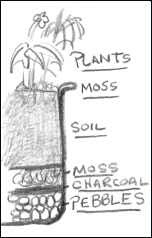The purpose of this article is to give examples of spaces that can be used for smart and sustainable indoor plant growing projects. In college there are three main types of living spaces: the dorm room, the apartment, and the house. Depending on where one stays space maybe limited or copious. Available space factors greatly into the size of prospective projects. Before I go into the various examples, it must be stated that one should at minimum tell roommates of the plan to grow plants in any shared living space. Also, make sure there are not any rules against having plants because fines are a waste of money.
The Dorm Room

Unfortunately, dorms have the least amount of space available. However, dorms offer a few spaces that can be used to grow small scale projects. The sunlight provided by
Windows are the leading places for sustainable projects. If the window does not have a ledge or one that is large enough, try a nightstand or something similar that can be placed adjacently and will provide more surface area.
Shelves and Cabinets are other good places because they exemplify the practice of vertical agricultural, a technique being used in urban development. Multiple plants can be grown on shelves/cabinets and to assure proper lighting cheap grow lights can be secured to them. Be sure there is appropriate space for plants to grow to their maximum height. Also, that the weight of the plant contains, soil, and water are not too heavy.
Last but not least are
Closets. If a closet is large enough a project utilizing grow lights can be very product and rewarding. Be sure to properly arrange clothes so that electrical cords and soil do not come in contact with the fabrics.
Apartments
All the same examples of the dorm room can be applied to Apartments. However, an important concern for projects being conducted in apartments is the cost of electricity. Be sure to plan and incorporate this effect into budgets. Also, research the various types of low cost lights and use sunlight as much as possible.

The best place in some apartments for space and harvesting sunlight is the
Balcony or Porch. Along with furniture, a good selection of plants make great decorations in these spaces. Not to mention that free photosynthesis and water are the best ways to have a low impact on the environment. When using balconies or porches take into consideration the amount of exposure to sunlight and seasonal changes in temperature. Pick plants that are versatile and hardy. Also, be sure that everything is properly secured in the event of storms.
A more difficult place to start and maintain plants is the
Bathroom. If fortunate enough to have a large bathroom one can have use indoor plants as a great focal point. The steam from showers will help to keep the plants hydrated. With a little innovation it is possible to grow various plant such as herbs and spices in a bathroom.
Next is the
Walk-in Pantry or Laundry Room. Like the closet, with proper arrangement and lighting these types of spaces can be very productive. Many have over head shelves that tend to become cluttered with random items so, why not grow indoor plants instead? To maintain functionality take the time to plan and implement space saving ideas.
Houses
Houses offer the greatest amount of space and opportunity for environmentally friendly projects. Houses have all the benefits of Apartments and Dorms plus more. From composting to aquaculture, houses can host multiple projects, all of which can be integrated for maximum productivity and minimum impact on the environment. Later posts will go in depth on this type of ecological projects.
Basements are the perfect place to practice sustainable growing. Without drastic changes in climate, harsh conditions, and the added benefit of controlled lighting, basements are generally the largest and most stable space for a college student to practice a green lifestyle. Again, be sure to properly plan for electricity requirements and arrangements to maintain the space's functionality.
Rooms can also be dedicated to indoor plant growing. Rooms have the same potential as basements and require the same forethought in planing. Unlike basements however, rooms typical have more sunlight via windows. Again, by using natural light the impact of a project is greatly reduced.
Also like Apartments,
Balconies and Porches can be used as fore-mentioned.

The greatest and most rewarding of all spaces is the
Yard or Acreage. Having a lot of space means more projects and produce. Learning to utilize land can greatly reduce the cost of groceries. Also, there is a positive physical health aspect and mental satisfaction from cultivating land for sustenance. Granted land takes more maintenance, but the end result can benefit the grower, local community and global community.
Whatever type of space you have, College Sustainable is here to help you live a green lifestyle while tackling the books. If you have any ideas to help others live a smarter and more sustainable life please feel free to tell us because one can save others simply by sharing.
Do you have a project, story, or idea you’d like to share with us? Hit us up on social media or contact Phillip Stringer at info@collegegogreen.org
Twitter: @CollegeGoGreen
Facebook: College Go Green
















